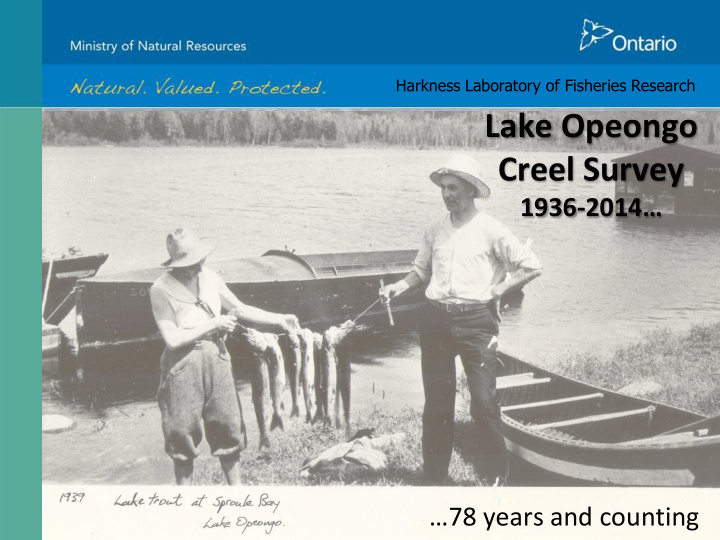



Harkness Laboratory of Fisheries Research Lake Opeongo Creel Survey 1936- 2014… …78 years and counting
Build it and they will come….. Highway 60 near Lake of Two Rivers – 1950’s Opeongo road - 1942
Establishment of Harkness Lab - 1936 Costello Lake Camp Log Lab – Current Site
Establishment of Park Creel Surveys
Lake Opeongo
Creel Beginnings Census anglers harvest and effort Obtain biological samples from lake trout, smallmouth bass and brook trout No schedule initially, merely tried to interview all anglers Cleaned fish in return for information and samples
Current Sampling Stratified, randomized sampling schedule Differentiate between overnight and day tips Collect biological information from LT and SMB • Length, weight, sex, maturity • Gonad condition and weight • Calcified aging structures • Ancillary sampling depending on project Component of mark/recapture
Evolution of the Opeongo Creel Type of angling/angler • 50’s saw an increase in overnight camping • Decrease in guided trips (CUE 1.5-2 X higher with guides) Algonquin Park Interior Campers Daytrip/Overnight CUE 80 6 Day Trip/Overnight CUE Thousands of Campers 70 5 60 4 50 40 3 30 2 20 1 10 0 0 1955 1960 1965 1970 1975 1980 1985 1990 1995 2000 2005 2010 2015 Year Year
Evolving Fishery Changes in technology • 1930’s – use of William’s Wabler • 1940’s – switch from canoe to motorboats • 1960’s – use of depth sounders/fish finders • 1980’s – downriggers • 2000’s - GPS units, bathymetric charts Is one hour of effort in 1930 equivalent to one hour of effort in 2012?
Lake Opeongo Lake Trout Harvest and Effort (1936-2012) 50000 4500 45000 Establishment of Lake Herring 4000 Lake Trout Targetted Effort (angler hours) 40000 3500 Establishment of Smallmouth Bass Total Harvest of Lake Trout 35000 3000 30000 2500 25000 2000 20000 1500 15000 1000 10000 500 5000 0 0 1925 1935 1945 1955 1965 1975 1985 1995 2005 2015 Year
Lake Opeongo Adult Lake Trout Population (8-20 years of Age) 7000 0.6 Number of Adult Lake Trout (8-20 years) 6000 0.5 5000 Harvest per Unit Effort 0.4 4000 0.3 3000 0.2 2000 0.1 1000 0 0 1940 1950 1960 1970 1980 1990 2000 2010 Year Reproduced from Vascotto, 2006
1948 Lake Herring Effect
Lake Opeongo Lake Trout Harvest and Effort (1936-2012) 50000 4500 45000 Establishment of Lake Herring 4000 Lake Trout Targetted Effort (angler hours) 40000 3500 Establishment of Smallmouth Bass Total Harvest of Lake Trout 35000 3000 30000 2500 25000 2000 20000 1500 15000 1000 10000 500 5000 0 0 1925 1935 1945 1955 1965 1975 1985 1995 2005 2015 Year
Recent Trends
Possible Explanation Warmer climate = increased SMB survival Increased SMB predation on LH in the fall Observation of decrease in lake herring size and abundance Reduced particle size for lake trout = reduced growth
Role of the Opeongo Creel Harkness • Baseline data to support other Harkness research programs, recruit outside researchers • Outreach to anglers • Training platform for students, future fisheries professionals Algonquin Park • Integral component of fisheries monitoring, Interior vs. Corridor effort, Sustainability of lake trout fisheries • Sampling for invasive / non-native species
Role of Opeongo Creel - Provincially One of few long term data sources for lake trout Useful and been used for examining: • Effects of climate change on food web dynamics • Evolutionary pressures of harvesting • Effects of harvesting on size structure • Effects of species introductions on lake trout food webs
Lake Opeongo Lake Trout Harvest and Effort (1936-2012) 50000 4500 45000 Establishment of Lake Herring 4000 Lake Trout Targetted Effort (angler hours) 40000 3500 Establishment of Smallmouth Bass Total Harvest of Lake Trout 35000 3000 30000 2500 First Rock Bass Observation 25000 2000 20000 1500 15000 1000 10000 500 5000 0 0 1925 1945 1965 1985 2005 2025 Year
Importance of the Creel An early landmark paper by Professor Fred Fry in the statistics journal Biometrics developed methodology to analyze creel survey data (Fry, 1949)
Recommend
More recommend